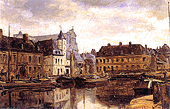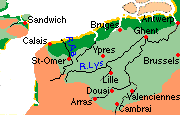Early
river trade

& working canals
|
Medieval river
trade 17th century Spanish
canals 18th century French
canals To create a new water route within the French frontier, the River Aa was canalised up to St-Omer, with a big tide lock near the sea at Gravelines. Behind the lock, the Canal de Bourbourg was cut through the marshes, linking the Aa to Dunkerque. Barges could trade along the coast without having to brave the North Sea In 1760, the Neufosse canal was built to link the river Lys to the Aa, and give Lille and other inland towns a French route to the sea. |
|
 MAP: the North's canal and waterway network - see 'Waterways' for more information about boat trips, hire boats and leisure boating facilities. |
|
|
Coal & grain by
barge |
|
  3. Paris quayside below Notre-Dame bridge. Barges unloading food and firewood for Paris in mid-18th century - before the St-Quentin Canal (1810) there was no direct waterway l ink between Paris and the productive farms of the North. 4. A century later, canals were a well established to transport grain barges on the river Scarpe at Arras in 1875. Painting of "The Old Bank in Arras" [artist unknown] |
|
|
Nineteenth century
canals |
|
   5. 'Les Fontinettes' barge lift at Arques- opened in 1888 to relieve traffic jams at a flight of locks on the busy canal from Lille and the coal-mines to the coast. 6. Coal barges in the 1950s. 7. Canal de Bourbourg: a broad deep canal, enlarged in the 'sixties, but water-borne freight traffic did not develop as much as was hoped. |
|
|
Canal du
Nord |
|
|
Coal closures and river
tourism |
|
|
|
Places
to visit: |
|
Related background
information |
|
|
|
|

